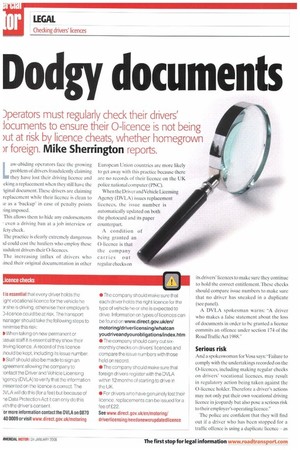ice nce checks
Page 28

If you've noticed an error in this article please click here to report it so we can fix it.
is essential that every driver holds the ight vocational licence for the vehicle he )r she is driving, otherwise their employer's D-licence could be at risk. The transport nanager should take the following steps to ninimise this risk: • When taking on new permanent or :asual staff it is essential they show their iriving licence. A record of this licence ;hould be kept, including its issue number. P Staff should also be made to sign an igreement allowing the company to ;ontact the Driver and Vehicle Licensing kgency (DVLA) to verify that the information resented on the licence is correct. The )VLA will do this (for a fee) but because of le Data Protection Act it can only do this vith the driver's consent.
or more information contact the DVLA on 0870 40 0009 or visit www.direct.gov.uk/motoring
• The company should make sure that each driver holds the right licence for the type of vehicle he or she is expected to drive. Information on types of licences can be found on www.direct.gov.uk/en/ rnotoring/driverlicensing/whatcan youdriveandyourobligations/index.htm • The company should carry out sixmonthly checks on drivers' licences and compare the issue numbers with those held on record.
• The company should make sure that foreign drivers register with the DVLA within 12 months of starting to drive in the UK.
• For drivers who have genuinely lost their licence, replacements can be issued for a fee of £22.
See www.direct.gov.uic/en/motoring/ driverlicensing/needaneworupdatedlicence








































































































































































